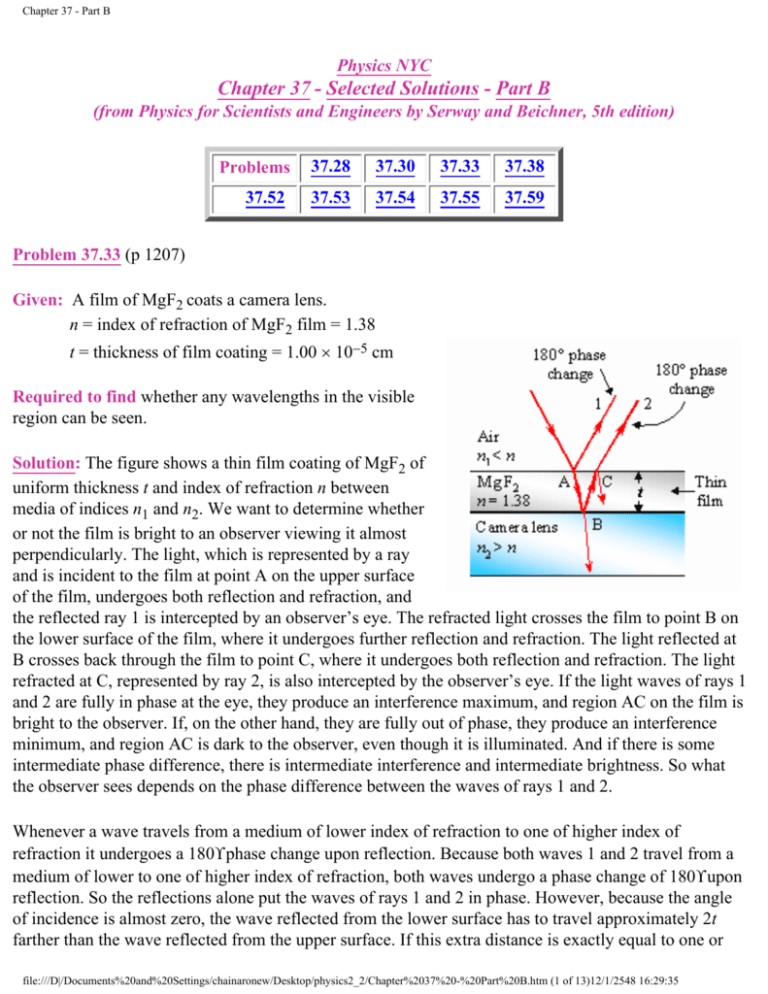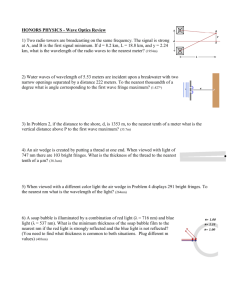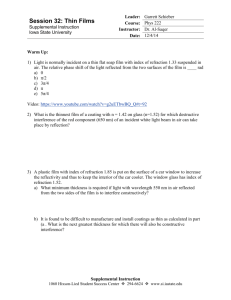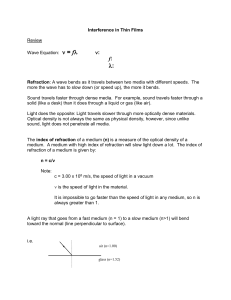Chapter 37 - Part B
advertisement

Chapter 37 - Part B Physics NYC Chapter 37 - Selected Solutions - Part B (from Physics for Scientists and Engineers by Serway and Beichner, 5th edition) Problems 37.52 37.28 37.30 37.33 37.38 37.53 37.54 37.55 37.59 Problem 37.33 (p 1207) Given: A film of MgF2 coats a camera lens. n = index of refraction of MgF2 film = 1.38 t = thickness of film coating = 1.00 × 10−5 cm Required to find whether any wavelengths in the visible region can be seen. Solution: The figure shows a thin film coating of MgF2 of uniform thickness t and index of refraction n between media of indices n1 and n2. We want to determine whether or not the film is bright to an observer viewing it almost perpendicularly. The light, which is represented by a ray and is incident to the film at point A on the upper surface of the film, undergoes both reflection and refraction, and the reflected ray 1 is intercepted by an observer’s eye. The refracted light crosses the film to point B on the lower surface of the film, where it undergoes further reflection and refraction. The light reflected at B crosses back through the film to point C, where it undergoes both reflection and refraction. The light refracted at C, represented by ray 2, is also intercepted by the observer’s eye. If the light waves of rays 1 and 2 are fully in phase at the eye, they produce an interference maximum, and region AC on the film is bright to the observer. If, on the other hand, they are fully out of phase, they produce an interference minimum, and region AC is dark to the observer, even though it is illuminated. And if there is some intermediate phase difference, there is intermediate interference and intermediate brightness. So what the observer sees depends on the phase difference between the waves of rays 1 and 2. Whenever a wave travels from a medium of lower index of refraction to one of higher index of refraction it undergoes a 180° phase change upon reflection. Because both waves 1 and 2 travel from a medium of lower to one of higher index of refraction, both waves undergo a phase change of 180° upon reflection. So the reflections alone put the waves of rays 1 and 2 in phase. However, because the angle of incidence is almost zero, the wave reflected from the lower surface has to travel approximately 2t farther than the wave reflected from the upper surface. If this extra distance is exactly equal to one or file:///D|/Documents%20and%20Settings/chainaronew/Desktop/physics2_2/Chapter%2037%20-%20Part%20B.htm (1 of 13)12/1/2548 16:29:35 Chapter 37 - Part B more wavelengths inside the film, the wave reflected from the lower surface will meet crest to crest with waves reflected from the upper surface and constructive interference will occur. Thus, the film is bright to the observer if 2 t = m λn ( m = 1, 2, 3, … ) where λn = wavelength of light inside the film = λ /n, and λ = wavelength of light in free space (or in air). One wavelength corresponds to each value of m. ∴2t=mλ/n ⇒ λ=2nt/m λ = 2(1.38)(1.00 × 10−7m)/m = 2.76 × 10−7 m/m ⇒ λ = 276 nm/m As we set successively m = 1, 2, 3, ..., we notice that the value of λ decreases, and all wavelengths are ≤ 276 nm. Because the visible spectrum consists of wavelengths in the range 400 to 700 nm, this means that there is no wavelength intensified in the reflected light. As a matter of interest, glass lenses used in cameras are usually coated with a transparent thin film to reduce unwanted reflection and therefore enhance the transmission of light through the lenses. Problem 37.28 (p 1207) Given: A soap bubble is floating in air. n = index of refraction of the soap bubble t = thickness of the bubble wall = 115 nm Required to find: λ = the wavelength of the light most strongly reflected Solution: The colors observed when white light is incident on the soap film result from the interference of waves reflected from the front and back surfaces of the film. (See the solution of Problem 37.33 for a detailed explanation of interference in thin films.) Here again we assume that the light rays traveling in air are nearly normal to the surfaces of the film. Ray 1, which is reflected from the front surface of the film (A), undergoes a phase change of 180° with respect to the incident wave because it is reflected from a medium that has a higher index of refraction than the one in which it was traveling. Ray 2, which is reflected from the back surface of the film (B), undergoes no phase change because it is reflected from a medium (air) that has a lower index of refraction. Hence, there is a phase difference of 180° (which file:///D|/Documents%20and%20Settings/chainaronew/Desktop/physics2_2/Chapter%2037%20-%20Part%20B.htm (2 of 13)12/1/2548 16:29:35 Chapter 37 - Part B corresponds to a path difference of ½ λn) between rays 1 and 2 due to the reflections from the two surfaces of the film. But ray 2 has to travel an extra distance 2t within the film before the waves recombine in the air outside surface A. So, for the rays to recombine in phase (to have constructive interference), we require that 2 t = (m + ½)λ n = (m + ½)λ /n 2 n t = (m + ½)λ (m = 0, 1, 2, 3, ...) (1) Here λn represents the wavelength of the light in the soap bubble and λ represents the wavelength of the light in air. Solving for λ we get If we set successively m = 0, 1, 2, 3, ..., we find that λ = 612 nm, λ = 204 nm, λ = 122 nm, etc., that is, as the value of m increases, the value of λ decreases. Because wavelengths of light below 400 nm are not in the visible range, the wavelength of the light most strongly reflected by the soap bubble is λ = 612 nm Problem 37.30 (p 1207) Given: A thin film of oil is located on a smooth, wet pavement. n = index of refraction of the oil film = 1.25 λR = wavelength in air of the red color = 640 nm λB = wavelength in air of the blue color = 512 nm Required to find: t = the film thickness that will allow the red (R) component of white light to be strongly reflected and the blue (B) component of light to be absorbed file:///D|/Documents%20and%20Settings/chainaronew/Desktop/physics2_2/Chapter%2037%20-%20Part%20B.htm (3 of 13)12/1/2548 16:29:35 Chapter 37 - Part B Solution: The colors (or no color) observed when white light is incident on the oil film result from the interference of waves reflected from the two surfaces of the film. (See the solution of Problem 37.33 for a detailed explanation of interference in thin films.) Here again we assume that the light rays traveling in air are nearly normal to the two surfaces of the film. Ray 1, which is reflected from the upper surface of the film (A), and ray 2, which is reflected from the lower surface of the film (B), both undergo a phase change of 180° with respect to the incident wave because both are reflected from media of higher index of refraction. Hence, the net change in phase due to reflection is zero. Constructive interference of the red light (film appears predominantly red) occurs when the path difference between the waves is 2 t = mRλR = mRλR/n n 2 n t = mRλR ⇒ (1) Destructive interference of the blue light (film has no blue color) occurs when the path difference between the two waves is 2 t = (mB + ½)λB = (mB + ½)λB/ n n 2 n t = (mB + ½) λB ⇒ (2) Because the thickness of the film is the same for both colors, 2nt = 2nt. Hence, from Equations (1) and (2) we get mRλR = (mB + ½) λB ⇒ This equation is satisfied if mR = mB = 2. Substituting this value in Equation (1) gives 2(1.25) t = (2)(640 nm) ⇒ t = 512 nm Problem 37.38 (p 1208) Given: Two rectangular flat glass plates are in contact along one end and separated along the other end file:///D|/Documents%20and%20Settings/chainaronew/Desktop/physics2_2/Chapter%2037%20-%20Part%20B.htm (4 of 13)12/1/2548 16:29:35 Chapter 37 - Part B by a sheet of paper. n = index of refraction of the two rectangular flat plates = 1.52 t' = thickness of the sheet of paper = 4.00 × 10−3cm = 4.00 × 10−5m λ = wavelength of light which illuminates top glass plate = 546.1 nm = 5.461 × 10−7m Required to find the number of dark parallel bands crossing the top plate. Solution: Assume that the light is incident on the upper plate at nearly normal incidence. Consider the interference between waves 1 and 2 reflected from the top (A) and from the bottom (B) of the air wedge of variable thickness t. Wave 1 undergoes no phase change upon reflection from a medium of lower index of refraction. Wave 2 undergoes a phase change of 180° upon reflection from a medium of higher index of refraction. Hence, there is a phase difference of 180° (which corresponds to a path difference of ½ λn) between waves 1 and 2 due to the reflections from A and B. But wave 2 has to travel an extra distance (down and up) within the air wedge. This distance is equal to 2t for normal incidence, where t is a variable. So dark bands will be produced when 2 t = mλ ( m = 0, 1, 2, 3, …) where λ = wavelength of light in air. When the air wedge is as thick as the sheet of paper, that is, when t = t', But the number of bands must be an integer, so m = 146. Along the edge of contact between the two plates the path difference between the upper and the lower reflected rays is zero. Because of the 180° phase change at the lower surface, however, the two reflected waves are 180° out of phase and destructive interference occurs. We therefore expect a dark band at the edge of contact between the two plates. Therefore, including the dark band at the zero thickness along the edge of contact between the two plates, there are 146 + 1 = 147 dark parallel bands. file:///D|/Documents%20and%20Settings/chainaronew/Desktop/physics2_2/Chapter%2037%20-%20Part%20B.htm (5 of 13)12/1/2548 16:29:35 Chapter 37 - Part B Problem 37.52 (p 1208) Given: The waves from a radio station can reach a home receiver by two paths. d = distance from transmitter to receiver = 30.0 km ½ d = halfway between transmitter and receiver = 15.0 km λ = wavelength broadcast by the radio station = 350 m = 0.350 km Find: h = the minimum height of the ionospheric layer that produces destructive interference between the direct and reflected beam, assuming no phase changes occur on reflection Solution: Let r1 = AC = path followed by the direct wave (wave 1), and r2 = AB + BC = the path followed by the reflected wave (wave 2). Because the reflection from the ionosphere takes place at a point midway between transmitter and receiver, AB = BC. Therefore, r2 = 2AB and the path difference between the two waves is ∆r = r2 − r1 = 2AB − AC Destructive interference between the two waves occurs when the path difference between them is equal to an odd number of half wavelengths. That is, when (m = 0, 1, 2, 3, …) To find the minimum height h, we set m = 0 in the above equation. This gives ⇒ h = 1.62 km file:///D|/Documents%20and%20Settings/chainaronew/Desktop/physics2_2/Chapter%2037%20-%20Part%20B.htm (6 of 13)12/1/2548 16:29:35 Chapter 37 - Part B As a point of interest, the ionosphere is the part of the earth’s atmosphere beginning at an altitude of about 40 km and extending outward 400 km or more. It contains free electrically charged particles by means of which radio waves are transmitted to great distances around the earth. (Webster’s dictionary.) Problem 37.53 (p. 1209) Given: Measurements are made of the intensity distribution in a Young's interference pattern (see Figure 37.6 on page 1192). When the wavelength of light is λ1 = 600 nm, I1/Imax = 0.810 at a particular value of y. Required to find the wavelength of light λ2 so that I2/Imax = 0.640 at the same y. Solution: The intensity distribution in Young's double slit interference pattern is given by (1) The phase difference φ depends on the path difference ∆ r according to the expression and the sinθ, for small angles, can be approximated to tanθ = y /L so that (2) If I1 = 0.810 Imax represents the intensity when the wavelength is λ1 = 600 nm and the phase difference is φ•, then, from Equation (1): If I2 = 0.640 Imax represents the intensity when the wavelength is λ2 and the phase difference is φ2, then, file:///D|/Documents%20and%20Settings/chainaronew/Desktop/physics2_2/Chapter%2037%20-%20Part%20B.htm (7 of 13)12/1/2548 16:29:35 Chapter 37 - Part B from Equation (1): so that (3) But, from Equation (2) (4) Comparison of Equations (3) and (4) gives: ⇒ λ2 = 421 nm Problem 37.54 (p 1209) Given: In a Young's double-slit experiment, the incident light includes light of two λ's. An overlapping interference pattern is formed on a screen. λ1 = one of the two wavelengths of the incident light = 540 nm = 5.40 × 10 λ2 = the second wavelength of the incident light = 450 nm = 4.50 × 10 d = separation between the two slits = 0.150 mm = 1.50 × 10 L = distance from slits to screen = 1.40 m −4 −7 −7 m m m Required to find: the minimum distance from the center of the screen to the point where a bright line of the λ1 light coincides with a bright line of the λ2 light. file:///D|/Documents%20and%20Settings/chainaronew/Desktop/physics2_2/Chapter%2037%20-%20Part%20B.htm (8 of 13)12/1/2548 16:29:35 Chapter 37 - Part B Solution: The figure shows the geometric construction for describing Young's doubleslit experiment. Consider the light of wavelength λ1. To reach any arbitrary point P on the screen, a wave from the lower slit S1 travels farther than a wave from the upper slit S2 by a distance ∆r = r2 − r1. If we assume that r1 and r2 are parallel, which is approximately true because L is much greater than d, then ∆r is given by ∆r = r2 − r1 = d sinθ. The value of ∆r determines whether the two waves are in phase when they arrive at point P. If ∆r is zero or some integer multiple of the wavelength, then the two waves are in phase at point P and constructive interference results. Therefore, the condition for a bright line, or constructive interference, at point P is ∆r = d sinθ1 = m1λ1 (m1 = 0, ± 1, ± 2, ± 3, ...) (1) (m2 = 0, ± 1, ± 2, ± 3, ...) (2) where m1 is the order number for the λ1 light. Similarly, for the light of wavelength λ2, ∆r = d sinθ = m2λ 2 2 Let P be the point where a bright line of the λ1 light coincides with a bright line of the λ2 light In this case, θ1 = θ2 = θ. Hence, from Equations (1) and (2) we get d sinθ = m1λ = m2λ 1 2 from where file:///D|/Documents%20and%20Settings/chainaronew/Desktop/physics2_2/Chapter%2037%20-%20Part%20B.htm (9 of 13)12/1/2548 16:29:35 Chapter 37 - Part B The minimum distance from the center of the screen to the point P occurs when m1 = 5 and m2 = 6. Therefore, For small angles, sinθ = tanθ and, from triangle OPQ, tanθ = y/L, where y = the minimum distance from the center of the screen to the point P. Solving for y we get y = L tanθ = (1.40 m)(tan 1.031°) = 0.0252 m ⇒ y = 2.52 cm Problem 37.55 (p 1209) Given: An air wedge is formed between two glass plates in contact along one edge and slightly separated at the opposite edge. The reflected light has 85 dark fringes when the plates are illuminated with monochromatic light from above. Find: N = the number of dark fringes that would appear if water (nw = 1.33) were to replace the air between the plates. Solution: Assume that the light is incident on the upper plate at nearly normal incidence. Consider the interference between waves 1 and 2 reflected from the top (A) and from the bottom (B) of the air wedge. Wave 1 undergoes no phase change upon reflection from a medium of lower index of refraction. Wave 2 undergoes a phase change of 180° upon reflection from a medium of higher index of refraction. Hence, there is a phase difference of 180° (which corresponds to a path difference of ½ λn) between waves 1 and 2 due to the reflections from A and B. But wave 2 has to travel an extra distance (down and up) within the air wedge. file:///D|/Documents%20and%20Settings/chainaronew/Desktop/physics2_2/Chapter%2037%20-%20Part%20B.htm (10 of 13)12/1/2548 16:29:35 Chapter 37 - Part B This distance is equal to 2t for normal incidence, where t is the maximum separation between the plates. So dark bands will be produced when 2 t = ma λn = ma λ/na (ma = 0, 1, 2, 3, …) where λn = λ = wavelength of light in the air, since the index of refraction of air = na = 1.00. When 85 dark fringes are observed, ma = 84. This is because the first dark band appears when ma = 0. Therefore, 2 t = 84 λ ⇒ t / λ = 42 If now water, of index of refraction nw = 1.33, replaces the air between the plates, 2 t = mwλn = mw λ/nw ( mw = 0, 1, 2, 3, …) where λn = λ / nw = wavelength of light in the water. Therefore, mw = 2nw(t/λ) = 2 (1.33)(42) = 111.7 But mw must be a whole number. So, mw = 111. Because the first dark fringe occurs when mw = 0, the total number of dark fringes that would appear if water were to replace the air between the plates is N = mw + 1 = 111+1 ⇒ N= 112 Problem 37.59 (p 1209) Given: A radio wave transmitter and a receiver located a distance h above the ground. file:///D|/Documents%20and%20Settings/chainaronew/Desktop/physics2_2/Chapter%2037%20-%20Part%20B.htm (11 of 13)12/1/2548 16:29:35 Chapter 37 - Part B d = distance between radio-wave receiver and transmitter h = height of both receiver and transmitter ½ λ phase shift occurs upon reflection of radio-wave from ground Required to find the longest wavelengths that interfere (a) constructively and (b) destructively. Solution: Let r1 = AC = path followed by the direct wave (wave 1), and r2 = AB + BC = the path followed by the reflected wave (wave 2). Assuming that the reflection from the ground takes place at a point midway between transmitter and receiver, AB = BC. Therefore, r2 = 2AB and the path difference between the two waves is ∆r = r2 − r1 = 2AB − AC (a) Since wave 2 has undergone a phase shift of ½ λ upon reflection from B, constructive interference between waves 1 and 2 occurs when their path difference is ∆r = (m + ½)λ (m = 0, 1, 2, 3, …) file:///D|/Documents%20and%20Settings/chainaronew/Desktop/physics2_2/Chapter%2037%20-%20Part%20B.htm (12 of 13)12/1/2548 16:29:35 Chapter 37 - Part B The longest wavelength corresponds to m = 0: ⇒ (b) Destructive interference between waves 1 and 2 occurs when their path difference is ∆r = m λ (m = 1, 2, 3, …) The longest wavelength is found when m = 1, i.e., when λ = ∆r, that is Back to Physics NYC - Home Page file:///D|/Documents%20and%20Settings/chainaronew/Desktop/physics2_2/Chapter%2037%20-%20Part%20B.htm (13 of 13)12/1/2548 16:29:35







